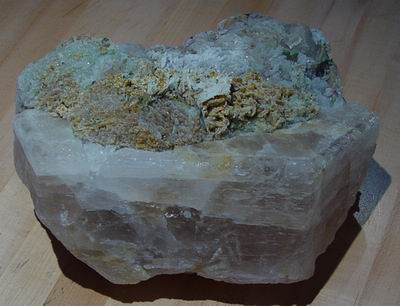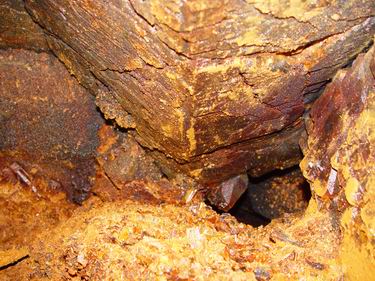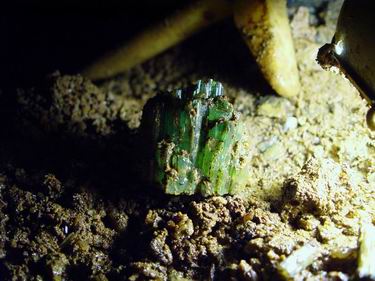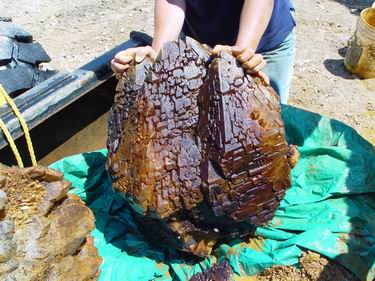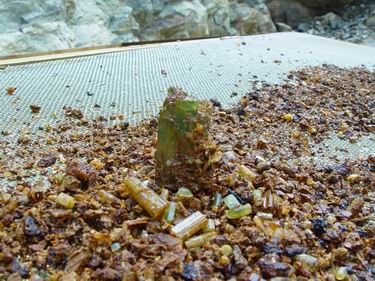
Tourmaline recovered August 2, 2005 from Mount Mica pocket 11-05.
It is 20 cm tall.
August 2nd proved to be a productive
day. Still digging straight into the pocket from where we had  intercepted it, we fiinally reached what
appeared to be the opposing wall, a distance of nearly 3m. As we
began excavating along the wall and towards the bottom, a
significant tourmaline was found. This tourmaline appeared to
have been attached to the wall at one point. Recovered with its base,
it was more than 20cm long. As most of the large tourmaline at Mount
Mica, it had multiple terminations. These graded from light to dark
green and where either translucent or transparent.( see image at the
top of the page) Within inches a beryl more than 35 cm across was also
found. The beryl had a covering of cleavelandite with small green
tourmaline along its terminal face. It had apparently responded to the
changing environment within the pocket as it developed as there were
obvious zones within the crystal. Although etched along its prism
faces, the beryl was intact. Frequenlty the beryls at Mount Mica are
thouroughly etched to mere fragments. Like all the other pocket
beryls we have
found at Mount Mica, it exhibited only a very pale pinkish color.
This crystal too was apparently once attached to the side wall of the
pocket. intercepted it, we fiinally reached what
appeared to be the opposing wall, a distance of nearly 3m. As we
began excavating along the wall and towards the bottom, a
significant tourmaline was found. This tourmaline appeared to
have been attached to the wall at one point. Recovered with its base,
it was more than 20cm long. As most of the large tourmaline at Mount
Mica, it had multiple terminations. These graded from light to dark
green and where either translucent or transparent.( see image at the
top of the page) Within inches a beryl more than 35 cm across was also
found. The beryl had a covering of cleavelandite with small green
tourmaline along its terminal face. It had apparently responded to the
changing environment within the pocket as it developed as there were
obvious zones within the crystal. Although etched along its prism
faces, the beryl was intact. Frequenlty the beryls at Mount Mica are
thouroughly etched to mere fragments. Like all the other pocket
beryls we have
found at Mount Mica, it exhibited only a very pale pinkish color.
This crystal too was apparently once attached to the side wall of the
pocket.
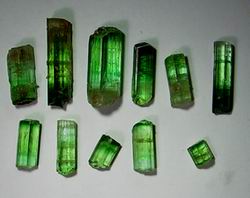 of the pocket tapered into multiple
narrow cavities. Each of these was filled with the productive golden
cookeite sand and it was from these small spaces the best gem material
emerged. Digging these was challenging and very wet and cold. Water
constantly flowed into the pocket. This continuous flow led us to
wonder whether more pocket lay in the immediate vicinity. of the pocket tapered into multiple
narrow cavities. Each of these was filled with the productive golden
cookeite sand and it was from these small spaces the best gem material
emerged. Digging these was challenging and very wet and cold. Water
constantly flowed into the pocket. This continuous flow led us to
wonder whether more pocket lay in the immediate vicinity. Each day for more than 6 weeks the pocket yielded up at least one specimen of either beryl or tourmaline that stood out from the rest. The pocket was producing quartz crystals in sizes from micro to mammoth. Many of these were scepters. Within the side cavites we found cleavelandite plates layed down in mutiple layers. One side of the plate would have a fine fabric like pattern of tourmaline. The other would be amost coral like in that hundreds of small tourmalines stood up like seaweed floating in the water from a bed of cleavelandite and lepidolite. Though once terminated, most of this fragile tourmaline was broken. When dug these plates looked like nothing more than rusty mud. Cleaned, many were strikingly beautiful and almost surreal.
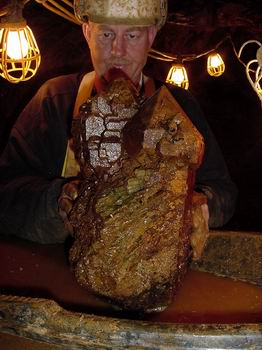 pieces was actually thrown
on to the muck pile. Richard
noticed what he thought was a piece pieces was actually thrown
on to the muck pile. Richard
noticed what he thought was a piece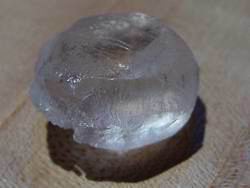 of quartz lit up by the afternoon sun
shining on the waste pile behind the screening table. On examination it
proved to be a flawless but colorless beryl. It's faces were lightly
etched giving it a distinictive nodular appearance. If found in a glass,
it would have been dismissed as an icecube. of quartz lit up by the afternoon sun
shining on the waste pile behind the screening table. On examination it
proved to be a flawless but colorless beryl. It's faces were lightly
etched giving it a distinictive nodular appearance. If found in a glass,
it would have been dismissed as an icecube.By the 1st week of September we had explored the pocket to a length of 13m. Quite frankly, the daily grind of digging this pocket was begining to exhaust us. It is hard to imagine that would be possible. The pocket had grown to such dimensions it required us to string lights inside. ( In the image to the left Richard steadies a scepter quartz crystal wtih attached tourmaline on our sled just prior to being drug out of the pocket. Leonard Himes photo) In another first, the proper working of this monster led us to drill and blast within the pocket. We did this several times. Although each small blast required tedious hand mucking, they seemed to rattle up tourmaline and beryl from parts unknown. It is quite probable that the walls of the pocket may have been laid down in layers with small cavities hidden behind the quartz crystals and cleavelandite. We blasted only a very small percentage of the pocket and removed the quartz crystals only if they blocked access to other chambers.
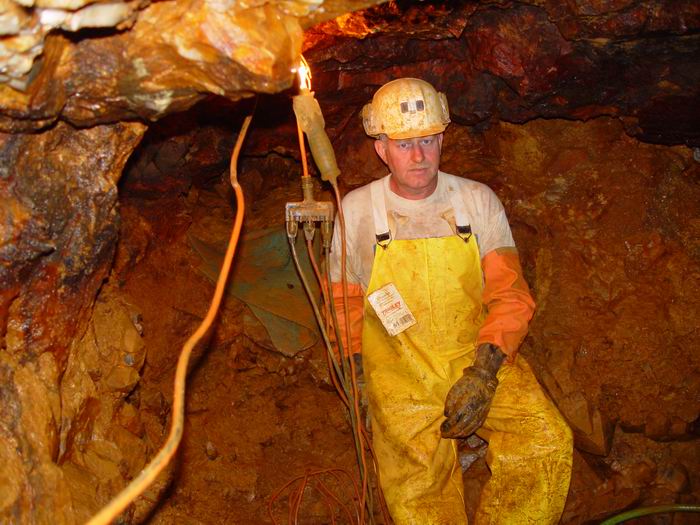 Richard ,leaning on the left side of the pocket, starts to show signs of being a little burned out. |
|||||
| Go to July/August : Page 1, 2, 3 |
